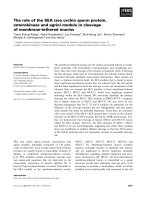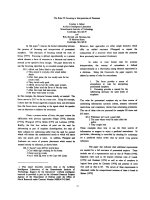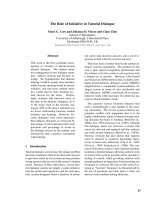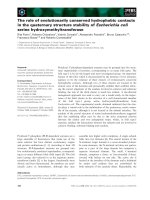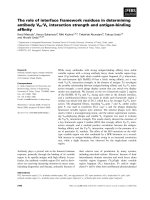Báo cáo khoa học: "The role of thyroid hormone therapy in acutely ill cardiac patients" pot
Bạn đang xem bản rút gọn của tài liệu. Xem và tải ngay bản đầy đủ của tài liệu tại đây (36.86 KB, 2 trang )
333
IL = interleukin; rT
3
= 3,3′,5′-tri-iodothyronine (reverse T
3
); T
3
= 3,3′,5-tri-iodothyronine; T
4
= thyroxine; TSH = thyroid-stimulating hormone.
Available online />Abstract
The presence of a ‘low T
3
syndrome’ in the setting of nonthyroidal
illness has long been recognized as the ‘euthyroid sick syndrome’,
with the recommendation to observe and not treat with thyroid
hormone replacement therapy. That approach has recently been
challenged in the setting of critical cardiac illness. Research
demonstrating that thyroid hormone therapy may improve
hemodynamic parameters has rekindled interest in the use of
thyroid hormone therapy in critical illness. Continued improvements
in survival after critical cardiac illness provokes the question of
whether thyroid hormone therapy would provide further incremental
benefit.
The question of whether thyroid hormone supplementation
should be provided to critically ill patients without a known
history of thyroid disease is not a new debate [1]. Analysis of
such patients led to the recognition of the euthyroid sick
syndrome, which is characterized by low normal thyroxine (T
4
)
levels, low normal 3,5,3′-tri-iodothyronine (T
3
) levels, variable
thyroid-stimulating hormone (TSH) levels and elevated
3,3′,5′-tri-iodothyronine (reverse T
3
; rT
3
) levels. The physio-
logic changes that lead to these alterations are the body’s
attempt to conserve metabolism during illness. T
4
is normally
metabolized through sequential deiodination to T
3
then to
3,3′-di-iodothyronine (T
2
), which is then rapidly degraded to
monoiodothyronines and thyronine [2]. Normally, about 40%
of secreted T
4
is monodeiodinated in the 5′ position to yield
T
3
, and a similar fraction is monodeiodinated in the 5 position
to yield rT
3
. The body responds to illness by shunting T
4
disproportionately towards rT
3
, which cannot be converted to
the biologically active form of T
3
but only deiodinated to T
2
.
Although this process makes sense teleologically as a form of
conservation of energy, these authors raise the question of
whether this could actually impair the body’s response to the
acute illness, namely the myocardial ischemia [3].
Unfortunately, they initially try to create an argument that the
acute episode was associated with relative hypotension to
the hypothalamic–pituitary axis leading to a ‘low T
3
syndrome’, although they are not able to offer any proof that
such ischemia occurs in their cohort. They do mention the
more likely etiology, which is cytokine-mediated suppression
of T
3
production. Cytokines, including IL-6, IL-1, and tumor
necrosis factor-α, contribute to the suppression of the 5′
deiodinase, thus shunting T
4
into rT
3
[4]. Cytokines can also
contribute to the suppression of TSH. This raises an
interesting question of whether the level of TSH, either in
itself or in how it changes over the illness, has any prognostic
information. Critically ill patients with the euthyroid sick
syndrome can have a very low TSH level or it can be as high
as 20 µIU/ml [5]. It is very possible that the higher TSH level
represents recovery manifested as an asynchronous return of
the hypothalamic–pituitary and thyroid axes to normal. Thus,
as they recover from the acute illness they seem, transiently, to
have a form of primary hypothyroidism. Because one does not
know what phase of recovery a patient has reached, we have
focused on maintaining the T
4
, which is the ‘storage form’ of
the hormone, in the normal range.
This study of patients with acute cardiac illness is of interest
because the authors are proposing that as we are able to
resuscitate many of these acutely ill patients they will then
have increased T
4
requirements, and the ‘low T
3
syndrome’
might actually hinder our efforts. If this is a true ‘low T
3
syndrome’ due to hypothalamic–pituitary ischemia,
combination T
4
/T
3
therapy might be of value during the period
of decreased production. This could be differentiated from
the euthyroid sick syndrome by measuring reverse T
3
levels. If
it were truly a simple deficit in T
3
production, reverse T
3
should also be low. If reverse T
3
is high, then what these
authors are describing is truly the euthyroid sick syndrome.
Although the traditional approach is to not treat the euthyroid
sick syndrome with levothyroxine because it will all be
Commentary
The role of thyroid hormone therapy in acutely ill cardiac patients
Kathleen L Wyne
Assistant Professor, Division of Endocrinology and Metabolism, Department of Internal Medicine, University of Texas Southwestern Medical Center at
Dallas, Dallas, TX, USA
Author for correspondence: Kathleen L Wyne,
Published online: 13 June 2005 Critical Care 2005, 9:333-334 (DOI 10.1186/cc3738)
This article is online at />© 2005 BioMed Central Ltd
See related research by Iltumur et al. in this issue [ />334
Critical Care August 2005 Vol 9 No 4 Wyne
shunted into rT
3
, the authors ask whether we should consider
treating cardiac patients who have the euthyroid sick
syndrome with T
3
(and not T
4
) to facilitate cardiac recovery.
There is now evidence that the provision of T
3
improves
hemodynamic parameters after open-heart surgery [6-8].
Studies in animals have shown that T
3
administration after an
acute myocardial infarction is associated with a better left
ventricular ejection fraction, which is very thought-provoking
because left ventricular function is an important indicator of
outcome after an acute myocardial infarction [9]. Although
there will be resistance from the endocrinology community to
trials of T
3
therapy in acutely ill patients, one must carefully
consider whether it might have utility in a specific subset of
patients – as these authors propose – who have an acute
myocardial event. For that reason, this issue might need to be
considered seriously in a prospective randomized trial.
Competing interests
The author(s) declare that they have no competing interests.
References
1. Wartofsky L, Burman KD: Alterations in thyroid function in
patients with systemic illness: the ‘euthyroid sick syndrome’.
Endocr Rev 1982, 3:164-217.
2. Bianco AC, Salvatore D, Gereben B, Berry MJ, Larsen PR: Bio-
chemistry, cellular and molecular biology, and physiological
roles of the iodothyronine selenodeiodinases. Endocr Rev
2002, 23:38-89.
3. Iltumur K, Olmez G, Ariturk Z, Taskesen T, Toprak N: Clinical
investigation: thyroid function test abnormalities in cardiac
arrest associated with acute coronary syndrome. Critical Care
2005, 9:R416-R424.
4. Nagaya T, Fujieda M, Otsuka G, Yang J-P, Okamoto T, Seo H: A
potential role of activated NF-
κκ
B in the pathogenesis of
euthyroid sick syndrome. J Clin Invest 2000, 106:393-402.
5. De Groot LJ: Dangerous dogmas in medicine: the nonthyroidal
illness syndrome. J Clin Endocrinol Metab 1999, 84:151-164.
6. Carrel T, Eckstein F, Englberger L, Mury R, Mohacsi P: Thyronin
treatment in adult and pediatric heart surgery: clinical experi-
ence and review of the literature. Eur J Heart Fail 2002, 4:577-
582.
7. Klemperer JD: Thyroid hormone and cardiac surgery. Thyroid
2002, 12:517-521.
8. Rosendale JD, Kauffman HM, McBride MA, Chabalewski FL,
Zaroff JG, Garrity ER, Delmonico FL, Rosengard BR: Hormonal
resuscitation yields more transplanted hearts, with improved
early function. Transplantation 2003, 75:1336-1341.
9. Oshiro Y, Shimabukuro M, Takasu N, Asahi T, Komiya I, Yoshida
H: Triiodothyronine concomitantly inhibits calcium overload
and postischemic myocardial stunning in diabetic rats. Life Sci
2001, 69:1907-1918.




